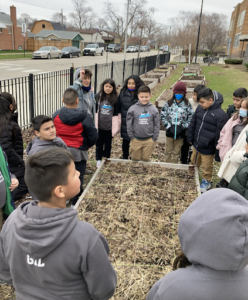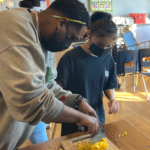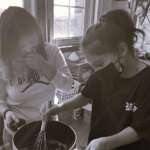Teachers Make Food Education Part of Everyday Learning with Pilot Light’s Fellowship
Launched in 2019, Pilot Light’s Food Education Fellowship is a year-long professional development and leadership experience for a cohort of PreK-12 teachers from across the country. Through the program, teachers build capacity and skills to make important food education part of everyday learning for their students.
Each month, teachers in the Fellowship share stories of what food education looks like in their classrooms. Read on for examples of three of these lessons from fellows Claire O’Connor (Kindergarten), Liz Middendorf (4th Grade), and Kat Henry (6th-8th Grade). In each lesson, the teachers engaged their students in learning through food while teaching about food. These lessons provided students in all three classrooms with sensory opportunities to expand their palettes and learning!
Experiential Kindergarten Learning

Pre-K teacher Claire O’Connor brought food education to her young students with an exciting twist on St. Patrick’s Day. For her lesson “Eating the Rainbow,” Claire invited her students to think about fruits that spanned the colors of the rainbow. First, they brainstormed in groups, then shared their answers. Next, Claire surprised students with a delicious assortment of fruits that represented the colors of the rainbow. As they ate honeydew melon, mandarin oranges, pineapple, mango, strawberries, blueberries, raspberries, and kiwi, many commented that it was the first time they had tried some of the fruits. This innovative lesson expanded the students’ palette and increased their understanding of all the nutrients fruits have.
Integrating Food Education into a 4th Grade Classroom
 In her 4th-grade classroom, Liz Middendorf teaches multiple subjects and, through the Food Education Fellowship, is integrating food education into her core curriculum.
In her 4th-grade classroom, Liz Middendorf teaches multiple subjects and, through the Food Education Fellowship, is integrating food education into her core curriculum.
Let’s take a look at a recent math lesson. As part of the unit covering multiplication and fractions, Liz asked students to prepare a garden bed for planting by dividing it into sections.
To start, the students planned which vegetables to plant in each section. This exercise helped them better understand their math lesson and the work that goes into producing our food. Next, the class used these skills to plant cold-weather foods during March that will be ready to eat before their school year ends.
Liz also uses Pilot Light to support social-emotional learning and reading. For example, during a lesson on immigration, students read several books about how cultural food can promote a sense of belonging, including A Different Pond, Tani’s New Home, and Apple Pie 4th of July. Then, they discussed how food could make someone feel at home or out of place. In addition to language arts skills, this type of lesson builds empathy and understanding between classmates.
Building literacy and life skills through food education
 For her 6th-8th grade Special Ed Resource Reading classes, Kat Henry uses Pilot Light to create experiential lessons to build essential life skills for her students.
For her 6th-8th grade Special Ed Resource Reading classes, Kat Henry uses Pilot Light to create experiential lessons to build essential life skills for her students.
Kat taught students the main components of soup: fat, liquid, aromatics, and herbs/spices. Then, the class collaborated to decide who would lead each task to prepare the soup. During these hands-on lessons, Kat emphasized the importance of following directions and working as a team.

The class has used their skills to make a few soups, including curried cauliflower coconut and broccoli cheddar. Although it was the first time many had tried these soups, her students loved these soups. They were skeptical about trying something new, but they loved them. Using Pilot Light to teach through food creates a significant impact in the classroom by building skills like these.
Learn more about our Food Education Fellowship. We are accepting applications from PreK-12 teachers through May 23, 2022.



